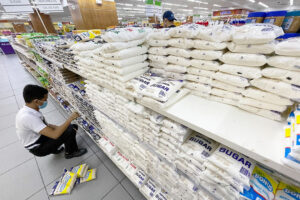




Policy Rate Updates: Double cut finale
 DOWNLOAD
DOWNLOAD

Monthly Economic Update: One for the road
 DOWNLOAD
DOWNLOAD

Inflation Update: Still low, still slow
 DOWNLOAD
DOWNLOAD


25-bp hike ‘most likely’ in March — BSP chief


THE BANGKO SENTRAL ng Pilipinas (BSP) will likely hike the benchmark rate again next month, with its governor eyeing a smaller 25-basis-point (bp) move amid signs of slower inflation in February.
“We’re actually looking at the month-on-month (inflation), but the most likely scenario is maybe one more hike,” BSP Governor Felipe M. Medalla told reporters on the sidelines of the annual reception of the banking community on Friday.
He said that a 25-bp hike is the “most likely” option at the March 23 meeting, due to a “great possibility” that inflation has already peaked in January as non-monetary measures are starting to dampen price increases.
“There are signs that (February inflation) will be (lower), there are lots of sugar imports and we’ll probably be seeing that with other products as well,” Mr. Medalla said in a mix of English and Filipino.
He also said that the economic team was able to convince Philippine President Ferdinand R. Marcos, Jr. to import more food items such as sugar.
At the same event on Friday, Finance Secretary Benjamin E. Diokno said February inflation is “definitely lower” than January.
“The price of oil has stabilized, peso has stabilized, all that’s left is food. We really have to focus on food items. It’s not just importation, but the food has to reach the market,” Mr. Diokno told reporters in a mix of Filipino and English.
“Right now, prices of sugar are still high,” he added.
The Sugar Regulatory Administration has issued Sugar Order No. 6 earlier this month, authorizing imports of 440,000 metric tons of the commodity, part of which would form a buffer stock in order to stabilize prices.
However, a higher month-on-month increase in February inflation may prompt a bigger move at the Monetary Board’s meeting on March 23, Mr. Medalla said.
“We’re still hawkish. If the results are bad, we will act… If the month on month is 1%, which implies a year on year of 12%, we have to act,” he added.
Inflation accelerated to a 14-year high of 8.7% in January from 8.1% in December. Stripping out seasonality factors, month-on-month inflation rose by 1% in January.
“The main impetus behind inflation is not demand. What’s happening is what we call second-order effects. Prices are rising because the previous increases influenced future increases,” Mr. Medalla said.
He reiterated that he expects inflation to return to within the 2-4% target range by November or December this year.
The BSP projects inflation to average 6.1% this year, higher than the actual 5.8% recorded last year, before easing to 3.1% in 2024.
Asked if another rate hike is possible at the Monetary Board’s next meeting after March, the BSP governor said it is “hard to forecast because the data is so fluid.”
After March 23, the BSP will discuss policy on May 18.
ING Bank N.V. Manila Senior Economist Nicholas Antonio T. Mapa expects the BSP to hike borrowing costs by 25 bps next month as well, adding that a whole-of-government approach is needed to address high inflation.
“BSP rate hikes can only do so much to quell demand hikes with supply-side remedies needing to kick in to make a dent in the inflation fight,” Mr. Mapa said.
“BSP will still need to hike to maintain the hawkish stance, but it’s clear that a 50 bps will not be able to effectively deal with searing price pressures, especially as the main driver for this episode is food inflation best addressed by the Department of Agriculture and Bureau of Customs,” he added.
Security Bank Corp. Chief Economist Robert Dan J. Roces said a month-on-month increase of about 0.3% may result to a year-on-year headline inflation of 8.9% this month.
“So, the risk is on the upside as disinflation lies in food prices which is a significant portion of the CPI (consumer price index). Solve the supply side there, then disinflation is guaranteed,” Mr. Roces said.
While many central banks worldwide, such as the US Federal Reserve, have slowed monetary tightening to 25-bp rate hikes this year, the BSP has so far stuck to large rate increases with the 400 bps in cumulative hikes since May 2022.
RRR CUT?
Meanwhile, the BSP may reduce banks’ reserve requirement as part of efforts to encourage financial institutions to cut or eliminate fees for small-value digital transactions.
“We are ready to collaborate with banks and payment system operators to explore a cost-sharing system that excludes small transactions from these types of fees,” Mr. Medalla said.
“We may even consider cutting the reserve requirement to enable banks to make these concessions. All these, in pursuit of a financial system that leaves no one behind,” he said.
The BSP earlier reduced the banks’ reserve requirement ratio (RRR) to 12% from 18%. It aims to reduce the country’s RRR, the highest in the region, to single digit this year.
Mr. Medalla said one way to make digitalization more inclusive is to make small transactions free of charge.
“If the fee is P15 for a P200 transaction, then the fee is quite large relative to the amount being sent,” he said.
The value of electronic fund transfers coursed through the PESONet and InstaPay rose by 36% to P955.9 billion in January from P702.6 billion in the same month last year, latest data from the BSP showed. The combined volume also grew by 25.8% to 58.922 million from 46.83 million in 2022.
Last year, the combined value of PESONet and InstaPay transactions went up by 36% to P9.94 trillion from P7.24 trillion in 2021, with the volume rising by 21% to 633.46 million from 523.59 million. — Keisha B. Ta-asan
This article originally appeared on bworldonline.com





 By BusinessWorld
By BusinessWorld